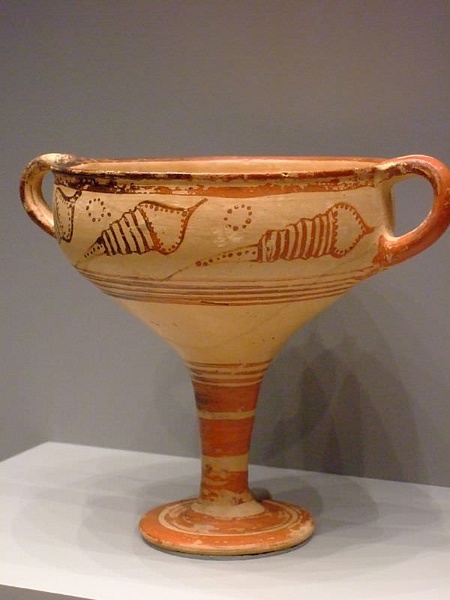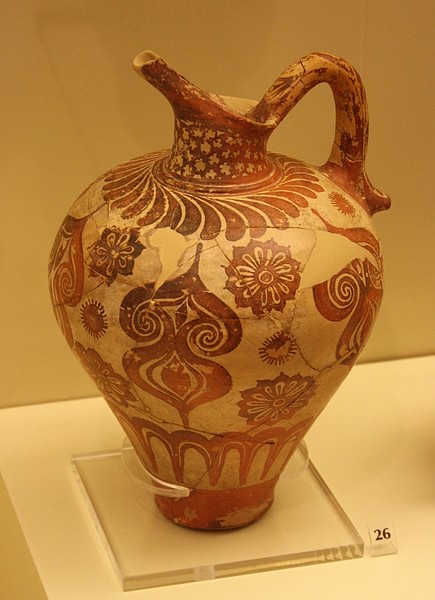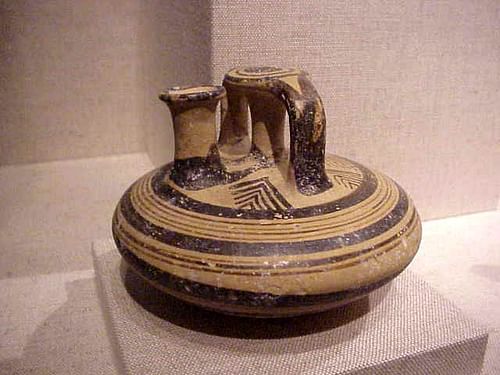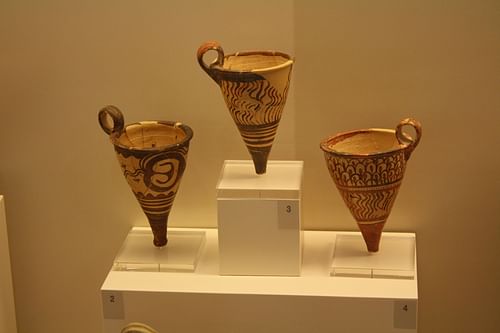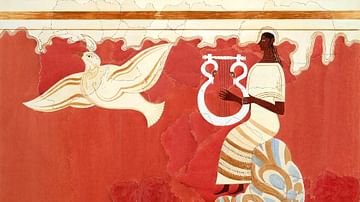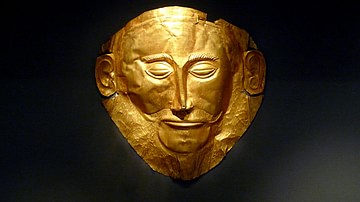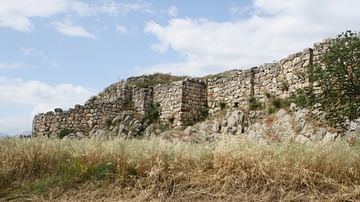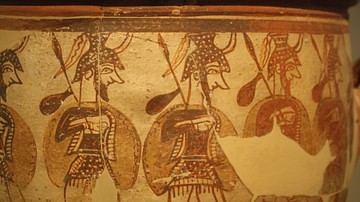The pottery of the Mycenaean civilization (1550-1050 BCE), although heavily influenced by the earlier Minoans based on Crete, nevertheless, added new pottery shapes to the existing range and achieved its own distinctive decorative style which was strikingly homogenous across Mycenaean Greece. Mycenaean wares typically display stylized representations of marine and plant life and show a fondness for minimalistic linear designs, a trend which would go on to influence the early pottery of Archaic and Classical Greece from the 9th century BCE.
Minoan Origins
Early wheel-made Mycenaean pottery (1550-1450 BCE) from mainland Greece has been described as 'provincial Cretan' which does convey the fact that although shapes and decorative styles were of Cretan origin, the final decoration was not quite as finely executed as in Minoan centres such as Knossos and Phaistos. However, despite this difference in quality, it is likely that Cretan potters did actually relocate to the mainland. In terms of raw material though, Mycenaean pottery is in fact often superior in quality to Minoan as the majority was made from old Yellow Minyan Clay and fired at higher temperatures than on Crete. The designs themselves were painted using a red to black, lustrous, iron-based clay slip (or 'paint') which had a tendency to become mottled depending on the firing process.
The Minoan love of flowing shapes and vibrant representations of animal, sea and plant life as expressed in their Marine and Floral styles was continued by the Mycenaeans with octopuses and nautiluses remaining particularly popular. Designs also continued to fill all of the decorative surface and follow the contours of the vessel. Gradually though, representations became more stylistic and more symmetrical with not all of the decorative space filled, leaving significant blanks, something rarely seen in Minoan pottery. Depictions of plants such as lilies, palms and ivy became more monumental, evolving into commonly employed motifs that were reserved principally for large jars.
From 1450 BCE the Mycenaean expansion overseas resulted in the taking over of the Cretan palaces and Mycenaean pottery began to dominate production across Greece and the Aegean islands. Indeed, pottery is the most important indicator we have of the political domination of the Mycenaeans across the Aegean. Decoration may be divided into two broad groups: the Pictorial style and the Pattern style. The former was influenced by contemporary fresco design and sought to represent scenes of daily life and the latter employed decorative scales, chevrons, and sea-life. Designs steadily became even bolder and more stylized, often with only a single motif design on each side of the vessel and an increase in the space left blank. Perhaps the most celebrated example of this minimalist style is the Ephyrean goblet, a stemmed, two-handled cup from Mycenae which is decorated with a single large rosette on each face. Plain, bold horizontal lines and whorls continue to be very popular forms of decoration and are usually well-chosen to complement the shape of the vessel.
Popular Vessels
Vessel forms also evolve, for example with stemmed cups the stems becoming longer and the bowls shallower over time. New types of vessel were produced such as one-handled teacups, tankards and jugs with vertical strap handles and either spouts or cut-away necks. The most popular Mycenaean vessel was the strirrup jar, so called because the handle resembles a double stirrup. The centre of the handle was often decorated to look like a spout whereas the true spout was in fact to the side and separate from the handle. Stirrup jars had first appeared on Crete in the 16th century BCE but they became much more common from the 14th century BCE, came in all sizes and were usually used to store wine and oils.
The second most popular vessel shape was the alabastron, a squat jar of various sizes, so named because the early examples were made from alabaster. The form first appeared in the 15th century on the Greek mainland and typically they have three small ribbon handles near the neck. Alabaster vessels were probably used to store unguents.
Some clay vessels were tin-plated, perhaps to imitate more costly silver items. In addition, many designs, in particular whorls, were most probably copied from metal vessels. Both of these facts illustrate that pottery was used by ordinary people who were unable to afford the more costly metal versions for their everyday needs.
The Evolution of Design
Over time, Mycenaean pottery decoration continued to become more and more abstract to the point where it is sometimes difficult to identify the original subject. The evolution of the octopus in pottery design is an excellent indicator of the changing style. An early octopus is more or less accurately represented and its twisting tentacles with detailed suckers randomly cover all of the vase but gradually they become more formal with tentacles painted symmetrically on either side of the body and finally the tentacles become mere lines, impossibly long in relation to the body size and usually fewer than eight are depicted.
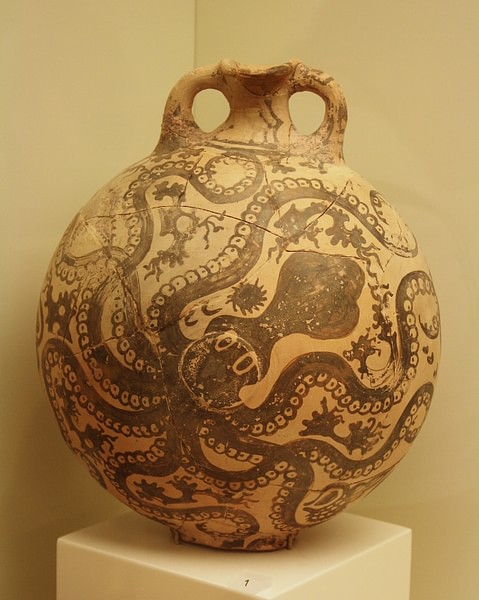
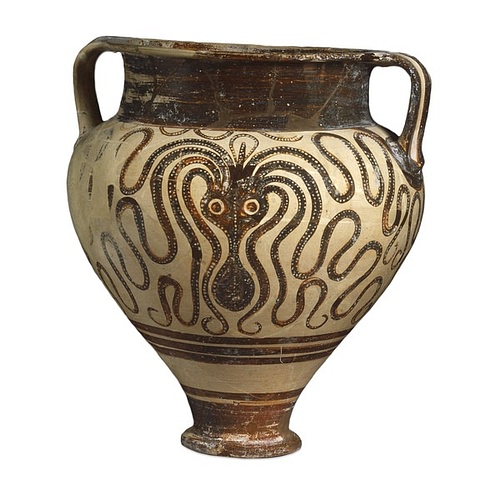
Dark bands of varying width become the principal form of decoration and only the space near the neck of vessels is used for pictorial representations. Particularly popular were chariot scenes which also included human figures, something extremely rare in Minoan pottery. Sacral knots, double axes and tusked helmets were popular subjects as were animals, birds and griffins, often arranged heraldically and themselves decorated with pattern designs, possibly imitating contemporary textile designs. An excellent example of this technique can be seen in the bull and bird decorated vase from the British Museum where the bodies are divided into sections, each decorated differently with dots, wavy lines, scales, crosses or chevrons. This vessel shape - the deep bowl - became very popular from the 13th century BCE and there are rare examples of white decoration on a dark background.
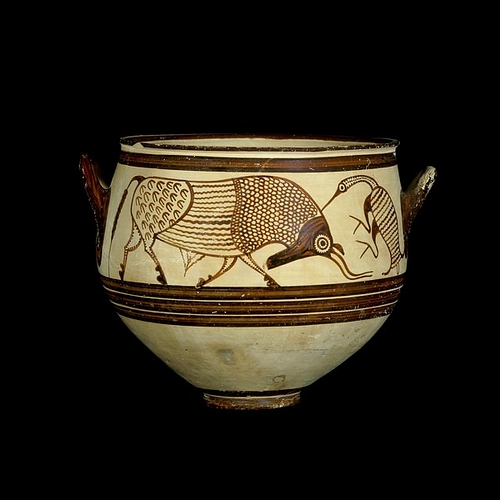
From the 12th century BCE greater regional variety is seen in pottery design and decoration, perhaps reflecting the political instability of that period as evidenced by settlement destructions. Designs may now be categorized into four broad groups. The first is the Closed style (of Cretan influence but originating in the Argolid) where all of the vessel or a designated area of it is filled with various patterns, usually rosettes and birds. The Fringed style mixes bold curves or lines with fringes and more detailed secondary decoration of fine lines in abstract patterns. The evolution of designs with octopuses is a sub-group of this style. The Pictorial style continues and a celebrated example is the Warrior Vase from Mycenae which depicts eleven marching warriors with spears and each carrying a bag, perhaps containing their daily food rations. A woman, standing to one side, bids them farewell. Interestingly, this would become a common theme in 4th to 5th century BCE Greek pottery. Finally, there is the Granary style which either displays a minimalistic decoration with only a few bands or wavy lines or in some cases the entire vessel is decorated in a monochrome slip or left completely undecorated. This rather poorer style was a precursor to the cruder sub-Mycenaean pottery prevalent from the 11th century BCE.
Figurines, Sarcophagi & Rhyta
Clay figurines have been found at sites across the Mycenaean Empire dating from the 14th to 12th centuries BCE and are remarkably similar in design. Highly stylized to the point of being almost unrecognisable as human forms, the figures are most commonly female and standing. Often these figures have two arms raised or crossed in front of the chest, a long skirt and a conical headdress. They are simply decorated with bold lines and sometimes jewellery is also painted on the figure using simple dots. There are also several examples of figurines depicting a woman clutching a child. Most probably these clay figures represent a nature goddess of Cretan origin as several have been found in a shrine context but other suggestions as to their function range from votive dedications to children's toys. On Crete, always a little different in their pottery, figurines during the Mycenaean period most commonly took the form of a large female figure (as tall as 75cm) with a hollow cylindrical lower half of the body and with raised arms. From 1200 BCE clay animal figures were also popular. Made on the wheel and with limbs and heads made by hand, they are simply decorated with lines and dots.
Clay sarcophagi had been widely used by the Minoans to bury their dead and they usually took the form of either a chest with short legs or a bath-tub and were decorated in much the same manner as pottery vessels. On Crete this tradition became even more popular in the Mycenaean period but examples elsewhere in the Mycenaean Empire are limited to a cemetery at Tanagra in Boeotia (1400-1200 BCE). Clay was also used to make rhyta - vessels used for pouring libations and ceremonial drinking during religious ceremonies. These are most commonly in a conical form and are decorated as contemporary pottery vessels.
The Mycenaean Legacy
Mycenaean pottery was exported and imitated not only throughout the Aegean but also in places as far afield as Anatolia, Syria, Egypt and Spain. There is also evidence that Mycenaean potters actually relocated and set up workshops abroad, particularly in Anatolia and southern Italy. Indeed, it may well be that designs of a Mycenaean origin introduced into these areas lived on to be re-introduced back to mainland Greece once the so-called Dark Ages had ended. This three century decline in all areas of culture but particularly in arts and crafts would, therefore, not be an end but only an interruption in the evolution of Greek culture. Pottery design would once more flower again with the geometric pottery of the 8th century BCE which certainly owed a great debt to the highly stylized pottery decoration so loved by the Mycenaeans.
